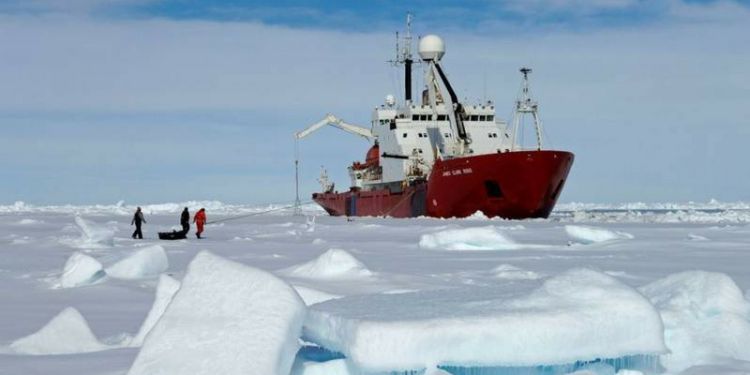Researchers return to Arctic Ocean to study climate change impacts

Scientists from the University of Leeds are among a team of researchers making a return voyage to the Barents Sea to carry out research on how climate change is affecting the Arctic Ocean ecosystem.
The scientific cruise is part of a UK flagship research programme, the Changing Arctic Ocean, funded by the Natural Environment Research Council (NERC). Scientists from several UK and European research institutes will be working on board the RRS James Clark Ross as the ship travels the length and breadth of the Barents Sea.
Warming in the Arctic region is increasing faster than elsewhere on the planet, making an unprecedented impact on how the Arctic ecosystem operates. One of the key drivers of change is the retreat of sea ice, which is at record lows. The team heading to the Arctic will investigate how the rapid retreat of sea ice affects the processes happening on the sea floor.
The ecosystem in the Arctic Ocean is heavily reliant on sea ice for the delivery of light and nutrients. The impacts of retreating sea ice affect the whole Arctic Ocean, including the sea floor as it depends on the downward drift of food from the surface to sustain animals living at the bottom.
Scientists from the programme’s Changing Arctic Ocean Seafloor (ChAOS) project will spend a month at sea collecting water, sediments, microbes and animals from the bottom of the Barents Sea.
Critical areas of interest will be the Polar Front, where the Atlantic enters the Arctic Ocean, and the edge of the sea ice, where marine ecosystems go from complete darkness during full winter sea ice cover to experiencing light again as the sea ice recedes during the transition to summer.
Dr Christian März, from the University of Leeds and lead investigator of the ChAOS project, said: “Our 2018 ChAOS cruise will be very exciting – which might be hard to believe if you tell people that we will return to the same locations in the Barents Sea we sampled in summer 2017.
“But going back to these places is exactly what makes our research relevant. It is the only way to determine if the changes in sea ice cover and water mass distribution we see from one year to the next leave an imprint at the Arctic seafloor as well.
“In addition, in 2018 we will have new collaborators from Norway and Belgium on board, and we will significantly expand our seafloor research program. With our experience from 2017, we will, for example, be able to sample animals from the seafloor much more systematically and preserve them in large aquaria for further research back at home.”
Scientists on the team from the Université Libre de Bruxelles will also test for methane emissions from the sea surface to the atmosphere by collecting samples of water and atmosphere.
Prof Steve Widdicombe, from Plymouth Marine Laboratory, is the Principal Scientific Officer and responsible for leading the 2018 ChAOS expedition. He said: “The Arctic Ocean is one of the most rapidly changing environments on our planet and, as marine scientists, it is certainly one of the most exciting and important environments for us to study.
“On last year’s expedition we encountered a lot of sea ice in the Barents Sea - at many of our sampling stations we had to break open this ice so we could collect our samples. This year satellite images have shown us there is almost no ice in the Barents Sea and ocean conditions are very different to last year.
“Whilst these dramatic differences in ice cover will give us a fantastic opportunity to study the effects of sea ice loss on the biodiversity and functioning of the seabed, I do hope this year proves to be an unusual event and does not signal the beginnings of regular ice-free summers in the Barents Sea.”
The ultimate goal of the £16 million Changing Arctic Ocean programme is to generate a better understanding of the Arctic so that computer models can more accurately predict future change to the environment and the ecosystem.
The programme has 16 projects with more than 170 scientists from 32 German and UK research institutes. The programme’s scientists are working closely with Arctic teams in 16 other countries, particularly Norway, Canada and Russia, to meet the programme’s objectives.
The outcomes of the programme will contribute to improving predictions of change in the Arctic of benefit to decision making at levels ranging from indigenous populations to international policy.




